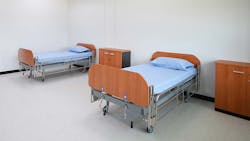A human being walking on a carpeted floor on a cold, dry day can generate 5,000 volts or more of static electricity. That’s why people literally get shocked when touching somebody else or a metal object. It’s also why medical equipment and electronics used in a medical office or lab can be vulnerable. It’s the big reason why the healthcare industry is taking a hard look at electrostatic discharge (ESD) flooring.
Static Electricity’s Impact on Patient Diagnosis
Among the many reasons for this concern is the impact static electricity can have on issues related to patient diagnosis and care. Data corruption can impact patient records, which play an extremely important part in diagnosis.
For example, a patient is allergic or has a bad reaction to a certain type of medication. That’s typically indicated in their record. If that record has been corrupted or unavailable due to the impact of static electricity—something the healthcare provider might not know at the time of treatment—it could have a disastrous impact.
Static electricity can also impact machines used for diagnosis, like MRI and X-ray machines, leading to diagnostic failure and patient discomfort.
The value of patient records and data goes far beyond the individual patient. During the pandemic, that information was critical in assessing the prevalence of COVID and whether things were getting better or worse.
Static Electricity’s Impact on Patient Care
Most everyone has received a shock after walking across a carpet and touching a metal object like a doorknob. Imagine receiving a shock as you were about to inject a patient with their medication? Or the patient receiving a shock as the medical practitioner was about to inject?
Controlling the static electricity in the examination or other room where treatment or diagnosis occurs goes a long way to protecting both patient and practitioner.
How ESD Flooring Can Help
ESD flooring does not prevent static electricity. It can significantly reduce static electricity to safe levels. Generally, in a healthcare setting, if static charges on people can be kept below 2,000 volts, many of the hazards can be significantly reduced. In a healthcare setting, this enables computers and electronics to function without the risk of data or machinery being damaged.
When the static electricity in a medical office, examination room or lab is under control, it helps ensure the data is accurate, giving the medical professional the information needed to diagnose and treat.
Typically, ESD flooring is used in an “ESD Controlled” environment and used in areas where there are very sensitive electronic components being assembled. In these types of environments, it’s important to keep voltages much lower, below 100 volts. To accomplish this, the flooring must be used in conjunction with ESD footwear so that there is a good electrical connection between the person and the floor.
Is Special Footwear Required in a Hospital or Healthcare Environment?
Fortunately, a healthcare setting, while being sensitive to ESD hazards, is not as sensitive as, say, an electronics assembly environment. So consequently, neither patients nor staff need to wear ESD footwear. That’s why when shopping for ESD flooring, it’s important to look at how different ESD floors perform with regular footwear and ensure that they are capable of keeping voltages on people below 2,000 volts.
A reputable flooring company that sells ESD flooring will test their products using regular footwear and all keep voltages below 1,000 volts.
The Downtime Questions
Downtime is another key consideration for a healthcare or medical facility, particularly if the room being refloored houses critical equipment (e.g., an MRI machine). Do your research. There are flooring products available that can be installed over existing flooring without adhesives and minimal preparation. These types of flooring greatly reduce, or even eliminate, downtime.
Sustainability Goals
Sustainability has become more of a consideration for facilities managers at healthcare facilities in recent years. That’s made interlocking flooring products more attractive to healthcare facilities. Not only does this type of flooring install easily, but it can be uninstalled and moved to another part of the facility should there be the need to relocate a room that requires ESD flooring.
Even better if said flooring is made from recycled products and is recyclable.
Maintenance
Maintenance is another key factor, as tiles in a medical facility need to be regularly cleaned to prevent the spread of germs. Some ESD products may require special cleaners, others might not. Again, you need to do your research.
The healthcare facility market continues to be focused on improving patient outcomes, safety and satisfaction for the patients and staff. Controlling static in these environments can benefit all of these factors. It can also reduce costs by helping to prevent issues from occurring in the first place.
About the Author
Thomas Ricciardelli
Thomas Ricciardelli is the president of SelecTech, Inc., a leader in the manufacture of innovative flooring products from recycled materials.
